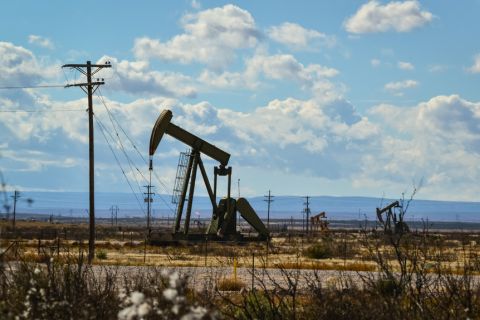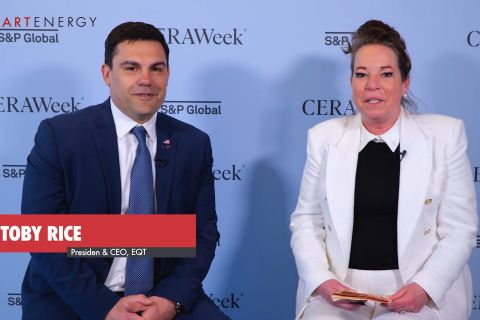Consensus 2004 oil-price expectations have risen 25% during the past year and by 13% in first-quarter 2004 alone-much greater rates of increase than were forecast for natural gas prices in both periods. All this is prompting a more bullish analyst stance on oil than has been witnessed in recent decades. "Oil has suddenly become the commodity with cachet," says Shannon Nome, E&P analyst with JPMorgan Securities in Houston. Indeed, the JPMorgan view calling for average $31-per-barrel oil prices this year remains well above recent consensus estimates by a margin of roughly $2.50. Not only that, the market-maker believes that crude prices will actually gain support from seasonality in the second quarter. "There is a widespread perception that the seasonal decline in global oil demand from the first to second quarter pressures crude prices," she observes. "However, evidence points to the opposite price trend typically occurring in the spring, as refiners gear up to build gasoline stocks ahead of the summer driving season." While the analyst's crude-price outlook does call for a seasonal moderation from very high first-quarter 2004 levels, she expects that decline to be only slight versus consensus estimates. "Our forecast from second-quarter through fourth-quarter 2004 is a flat $30-well supported by recently low crude and gasoline inventories." Naturally, there are risks to Nome's oil-price outlook. However, unless OPEC overproduces by 1 million barrels per day or more relative to its new 23.5 million barrel-per-day quota, she doesn't foresee an excessive second-quarter global inventory build. Such a robust outlook for crude would seem to auger well for oil-weighted equities. But the fact is, most oil-sensitive E&P stocks under Nome's coverage have actually performed only in line with their gas-sensitive cousins. During first-quarter 2004, both equity groups were up an average 14% versus a 4% move in the S&P 500. "This could present an interesting investment opportunity if oil prices continue to surprise to the upside, as we expect," she says. Also, the analyst notes that E&P companies are modestly less hedged on the oil side, "so they could feasibly participate to a greater extent in any potential upside surprise in crude oil prices." Although Nome believes oil-weighted Plains Petroleum and Unocal are well positioned to benefit from these outlooks, her top pick among the three oiliest E&P stocks is Apache Corp., whose stock she rated at press time as Overweight. Near-term, she points out, the company could benefit from its high-potential Black Dragon exploration wildcat in Australia, as well as results from its second well in the U.K. North Sea Forties Field. No less bullish about future oil prices is J. Marshall Adkins, managing director of energy research for Raymond James & Associates in Houston. He notes that many clients have jokingly referred to the firm's energy group as "perma-bulls" that have never met an energy-price forecast that was too high. This perception, however, doesn't mesh with reality, the analyst contends. "The facts show that our bullish oil-price forecasts, at least in the past two years, have actually proven to be consistently low," says Adkins. "In an effort to rectify this overly bearish track record, we are raising our 2004 oil-price forecast from $31 per barrel to $34.36 and our 2005 forecast from $32 per barrel to $33." Likewise, the Raymond James energy group is boosting its 2004 U.S. natural gas-price forecast from $5.40 per Mcf to $5.92 and its 2005 forecast from $5.75 to $6. One of the major reasons the team has upwardly revised its 2004 and 2005 oil-price forecasts is that it sees a growing disconnect between the International Energy Administration (IEA) global supply/demand data and global oil inventories. "It now appears that IEA concerns about second-quarter inventory builds were somewhat exaggerated," says Adkins. "We believe the IEA is simply underestimating global demand and overestimating oil supplies. Eventually, the facts will support our view that a strong global economic recovery, combined with a slowing in non-OPEC oil-production growth, is driving a much tighter global oil market than anticipated." Going forward, the analyst expects natural gas prices to be much more closely linked with oil prices than in the past decade, with a 5.5-to-1 oil/gas price ratio. Thus, he looks for natural gas prices to average just below $6 this year and right at $6 in 2005. Even though its 2004 oil-price forecast is more than $6 ahead of Street consensus, it is actually $1 below the futures market for 2004, says Adkins. "If we're right [about our oil-price forecasts], E&P companies' earnings are likely to be much higher than current consensus estimates and, likewise, E&P cash flows and capital expenditures on drilling are also likely to be much higher than consensus estimates." Adds Adkins, "Higher spending and price realizations will likely result in higher E&P stock-price evaluations and higher oilfield-service company evaluations during the coming years."
Recommended Reading
Athabasca Oil, Cenovus Energy Close Deal Creating Duvernay Pureplay
2024-02-08 - Athabasca Oil and Cenovus Energy plan to ramp up production from about 2,000 boe/d to 6,000 boe/d by 2025.
Novo II Reloads, Aims for Delaware Deals After $1.5B Exit Last Year
2024-04-24 - After Novo I sold its Delaware Basin position for $1.5 billion last year, Novo Oil & Gas II is reloading with EnCap backing and aiming for more Delaware deals.
CEO: EQT Positioned to Meet Demand of Power-guzzling AI Data Centers
2024-04-01 - EQT Corp.’s Toby Rice said demand for AI could exceed the power demand required to meet U.S. residential demand and jump 20% by 2030, in this Hart Energy Exclusive interview.
‘Monster’ Gas: Aethon’s 16,000-foot Dive in Haynesville West
2024-04-09 - Aethon Energy’s COO described challenges in the far western Haynesville stepout, while other operators opened their books on the latest in the legacy Haynesville at Hart Energy’s DUG GAS+ Conference and Expo in Shreveport, Louisiana.
Aethon’s Far Western Haynesville: Three Wells, 17.5 Bcf and Still Roaring
2024-02-05 - Aethon’s wells show no signs of flatlining—and neither are Comstock Resources’ tests, one of which has already reached nearly 50% of its previously estimated EUR.





